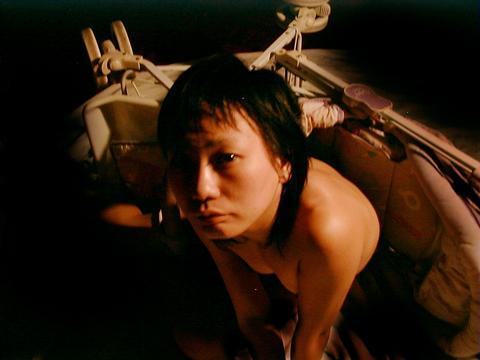Paris, summer 1971. A spotlight illuminates a crudely made-up king and queen sitting in a theater box. The audience turns to regard them. One of them eventually speaks. "Ladies and gentle ...(long pause) ... men! (Two minute pause). Deafman ... (even longer pause) ... glance!" And the house lights go down.
It was the opening of one of the strangest, and now one of the most historic, theater shows of an era that was full of surprises. The performers were some 20 New Yorkers, mostly students, plus another 15 or so French, similarly young, and an Englishman. The show, Deafman Glance, was the creation of a 30-year-old artist and former architecture student, Robert Wilson, and this was his fledgling company's first trip outside the US.

PHOTO COURTESY OF RIVERBED THEATRE
After a shaky start, the production proved a sensation among France's aesthetes and intelligentsia, with aged Surrealists driving up to Paris from remote villages to see it, and brawls at the box-office for tickets. After five weeks it closed, and Wilson went on to become one of the most celebrated theater artists of the modern era.

PHOTOS COURTESY OF RIVERBED THEATRE
The Englishman, as it happens, was me. I had wandered into the production as a roving reporter just at a time when they needed extra bodies. I ended up as a naked corpse partly covered in flowers, and was told that if I had to move it should be, like virtually everything else in the show, in glacial slow-motion.
In Taipei this week, Craig Quintero and his Riverbed Theatre are staging a show titled Life and Times of Robert Wilson at the National Theater's Experimental Theater from Thursday to Sunday based to some extent on Deafman Glance and the play's successors. Later in his career Wilson created several productions "about" famous 20th-century figures, and in his show, Quintero aims to turn the same kind of spotlight onto their creator.

PHOTOS COURTESY OF RIVERBED THEATRE
Like Wilson's own creations, this one will in no way seek to tell a story. Instead, it will evoke a style. Many of Wilson's trademark techniques -- pictorial images on a traditional proscenium-arch stage, side lighting, the performers as living sculptures -- will be incorporated, and some actual scenes from Deafman Glance will be re-created.
Talking to Craig Quintero is quite an experience. He has details of Wilson's work at his fingertips, and at the same time a strong sense of perspective about Wilson's oeuvre. While agreeing on the immense, though not uncontroversial, influence Wilson has had on theater, he feels that his classic shows were probably the early ones.
Today Wilson, while continuing to create productions using his now well-established style, is perhaps going through the motions, with the former human element largely missing. Quintero very much hopes this will be well and truly back in place in his own show.
The human was very much at the center of Deafman Glance. The entire production was a species of real-life ritual surrounding a teenage deaf-mute African-American boy named Raymond. Wilson had been told that, when very young, this boy could, in fact, hear and speak, but had lost the capacity as a result of a traumatic experience. By re-enacting events that might parallel this experience, in the presence of the on-stage Raymond, was it just possible that he would recognize something deep in his repressed memory, and there and then, on stage, regain the power of speech?
It was an extraordinary premise. But in that intoxicating era when altered states of consciousness were at the cutting edge of all the arts, just about anything was possible. Similarly, theater as magic and theater as rite were things whose time had come.
The paradox was, however, that this real-life human drama at the center of the stage drama was in strong contrast to the austerity and aesthetic purity of Wilson's general style.
As far as anyone knows, Raymond never regained his lost capacities. Wilson's style, however, has flourished, and voyaged on little-changed.
Magical transformations have a very long history in the theater, stretching back to its origins in temple dance-dramas, both in Asia and in Europe. In re-instituting the possibility of an actual transformation, Wilson was merely, albeit sensationally, taking theater back in the direction of its roots.
Taipei's Experimental Theater was deliberately designed to avoid the imposition of a proscenium arch on productions. Paradoxically, therefore, Riverbed has had to create one -- a box 10m wide, 5m deep and 5m high, with, if not actually a rising curtain, then at least the suggestion of a drawn-back one. Out of a cast of 18, six will embody Robert Wilson, in his trademark jeans and turtle-neck sweater, plus masks characterizing the man.
The music is the creation of the director's mother, Cheryl Quintero, featuring, among other things, the choir of her local church in Montana, a piano and a barber-shop quartet.
For a decade after Deafman, Wilson worked with composer Philip Glass, but subsequently, in shows such as The Civil Wars, he habitually used spirituals and other traditional African-American religious music. This aspect of Wilson's work will strongly influence the music this week, Quintero says.
And because Deafman Glance is now 34 years old, the characters' costumes will have the appearance of things taken out of a dusty cupboard, but brought back to life by the mysterious transforming power of theater.
Quintero is used to creating well-informed shows about some of his more spectacular theatrical predecessors. Last year Riverbed offered a show, The Futurist Cookbook, based on the concepts and practices of Filippo Tommaso Marinetti, the eccentric founder of futurism, in which audiences were invited to consume items created according to a cookbook that doesn't appear in many Taipei kitchens.
Life and Times of Robert Wilson will not attempt to ape Wilson's work. Instead, it will utilize elements of his manner, using pastiche and collage, to critique his creations. It will be a dialogue with Wilson, Quintero says. The hour-long performances promise to be extremely fascinating.
Riverbed Theatre's Life and Times of Robert Wilson plays at the Experimental Theater, Taipei from Thursday to Sunday at 7:30pm, with matinees on Saturday and Sunday at 2:30pm. Call (02) 3393 9888 for more information.

April 14 to April 20 In March 1947, Sising Katadrepan urged the government to drop the “high mountain people” (高山族) designation for Indigenous Taiwanese and refer to them as “Taiwan people” (台灣族). He considered the term derogatory, arguing that it made them sound like animals. The Taiwan Provincial Government agreed to stop using the term, stating that Indigenous Taiwanese suffered all sorts of discrimination and oppression under the Japanese and were forced to live in the mountains as outsiders to society. Now, under the new regime, they would be seen as equals, thus they should be henceforth

Last week, the the National Immigration Agency (NIA) told the legislature that more than 10,000 naturalized Taiwanese citizens from the People’s Republic of China (PRC) risked having their citizenship revoked if they failed to provide proof that they had renounced their Chinese household registration within the next three months. Renunciation is required under the Act Governing Relations Between the People of the Taiwan Area and the Mainland Area (臺灣地區與大陸地區人民關係條例), as amended in 2004, though it was only a legal requirement after 2000. Prior to that, it had been only an administrative requirement since the Nationality Act (國籍法) was established in

With over 80 works on display, this is Louise Bourgeois’ first solo show in Taiwan. Visitors are invited to traverse her world of love and hate, vengeance and acceptance, trauma and reconciliation. Dominating the entrance, the nine-foot-tall Crouching Spider (2003) greets visitors. The creature looms behind the glass facade, symbolic protector and gatekeeper to the intimate journey ahead. Bourgeois, best known for her giant spider sculptures, is one of the most influential artist of the twentieth century. Blending vulnerability and defiance through themes of sexuality, trauma and identity, her work reshaped the landscape of contemporary art with fearless honesty. “People are influenced by

The remains of this Japanese-era trail designed to protect the camphor industry make for a scenic day-hike, a fascinating overnight hike or a challenging multi-day adventure Maolin District (茂林) in Kaohsiung is well known for beautiful roadside scenery, waterfalls, the annual butterfly migration and indigenous culture. A lesser known but worthwhile destination here lies along the very top of the valley: the Liugui Security Path (六龜警備道). This relic of the Japanese era once isolated the Maolin valley from the outside world but now serves to draw tourists in. The path originally ran for about 50km, but not all of this trail is still easily walkable. The nicest section for a simple day hike is the heavily trafficked southern section above Maolin and Wanshan (萬山) villages. Remains of